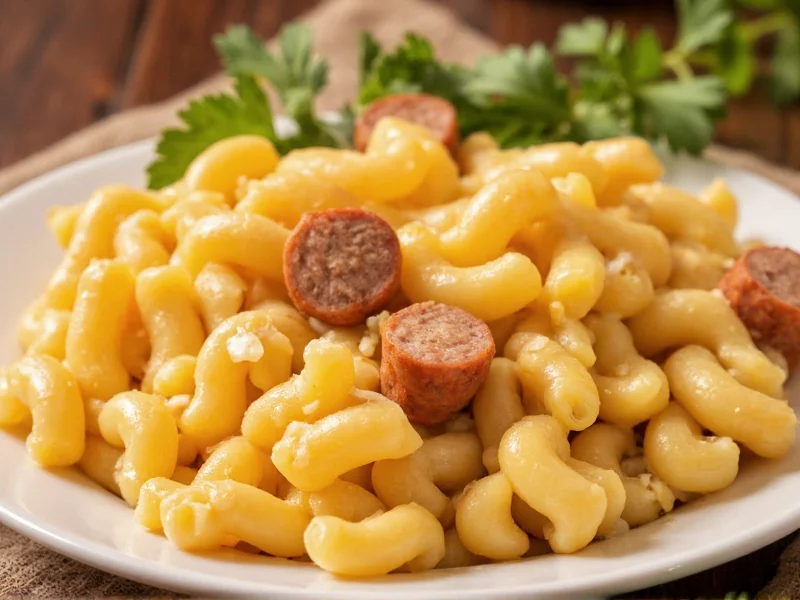Creating exceptional macaroni cheese with sausage requires understanding the synergy between creamy cheese sauce and flavorful sausage. This beloved comfort food fusion elevates traditional mac and cheese by adding protein-rich sausage that complements the cheesy base while providing textural contrast. Whether you're preparing a weeknight family dinner or entertaining guests, this dish delivers satisfying results when made with proper technique.
The Science Behind Perfect Macaroni Cheese with Sausage
The magic happens when quality ingredients meet precise cooking methods. Sausage selection dramatically impacts flavor profile—sweet Italian sausage creates a milder dish while hot varieties add spice. The cheese sauce requires careful temperature control to prevent separation, and pasta cooking time must be adjusted to account for continued baking.
Essential Ingredients Breakdown
Professional results depend on ingredient quality and proper ratios:
| Ingredient Category | Recommended Options | Why It Matters |
|---|---|---|
| Sausage | Italian (sweet or hot), kielbasa, or smoked sausage | Provides umami depth and protein; Italian sausage's fennel notes complement cheese |
| Cheese Blend | Sharp cheddar (60%), Gruyère (25%), Parmesan (15%) | Cheddar delivers classic flavor, Gruyère adds complexity, Parmesan enhances browning |
| Pasta | Elbow macaroni, cavatappi, or shells | Tube shapes hold sauce better; undercook by 2 minutes for perfect bake texture |
| Breadcrumb Topping | Panko, melted butter, garlic powder | Crisp texture contrast; prevents soggy surface during baking |
Step-by-Step Preparation Guide
1. Sausage Preparation (Critical First Step)
Brown 1 pound of sausage in a skillet over medium heat, breaking into small crumbles. Drain excess fat but retain 1 tablespoon for flavor. This renders fat properly while developing fond (browned bits) that enhances overall flavor. Never skip draining excess grease to prevent a greasy final product.
2. Cheese Sauce Technique
Create a roux with 4 tablespoons butter and 1/4 cup flour cooked for 2 minutes. Gradually whisk in 2 1/2 cups whole milk heated to just below simmering. Cook until thickened, then remove from heat before adding shredded cheese. Adding cheese off-heat prevents protein separation that causes grainy sauce. For easy macaroni cheese with sausage recipe success, shred cheese yourself—pre-shredded contains anti-caking agents that hinder melting.
3. Pasta and Assembly
Cook 16 ounces pasta al dente (2 minutes less than package directions). Combine with cheese sauce, cooked sausage, and optional additions like sautéed onions or bell peppers. Transfer to greased baking dish and top with buttered breadcrumbs.
4. Baking Parameters
Bake at 375°F for 25-30 minutes until bubbling at edges and topping is golden brown. Rest 10 minutes before serving—this allows sauce to set properly. For baked mac and cheese with Italian sausage perfection, insert an instant-read thermometer; internal temperature should reach 165°F.
Proven Variations for Different Preferences
Adapt this homemade sausage macaroni cheese to suit various dietary needs and taste preferences:
- Gluten-Free Version: Substitute gluten-free pasta and use cornstarch (2 tablespoons) instead of flour for sauce thickening
- Spicy Kick: Add 1/4 teaspoon cayenne pepper to cheese sauce and use hot Italian sausage
- Creamier Texture: Mix in 4 ounces cream cheese with the shredded cheese blend
- Kid-Friendly Option: Use mild sausage and add 1/2 cup diced ham for extra protein without strong flavors
Troubleshooting Common Issues
Even experienced cooks encounter challenges with macaroni cheese with sausage bake. Here's how to fix frequent problems:
- Grainy Sauce: Caused by high heat when adding cheese. Solution: Remove from heat completely before adding cheese, and use freshly shredded cheese
- Soggy Top: Breadcrumb topping absorbed moisture. Solution: Increase oven temperature to 400°F for final 5 minutes of baking
- Dry Texture: Pasta overcooked before baking. Solution: Undercook pasta by full 2 minutes and use generous sauce-to-pasta ratio (1.5:1)
- Greasy Separation: Too much sausage fat incorporated. Solution: Thoroughly drain sausage and blot with paper towels before adding to mixture
Serving and Storage Guidelines
For optimal mac and cheese with sausage dinner experience, serve with a simple green salad and crusty bread. Leftovers maintain quality for 3-4 days when stored in airtight containers. Reheat individual portions with 1 tablespoon milk per cup to restore creaminess. Freezing is possible for up to 2 months—thaw overnight in refrigerator before reheating at 350°F until internal temperature reaches 165°F.
Frequently Asked Questions
Can I use frozen sausage in macaroni cheese?
Yes, but thaw completely before cooking. Frozen sausage releases excess water during cooking, which can make your dish watery. For best results with frozen sausage macaroni cheese, thaw overnight in refrigerator and pat dry before browning.
What's the ideal cheese ratio for macaroni cheese with sausage?
The optimal blend is 60% sharp cheddar for classic flavor, 25% Gruyère for complexity and meltability, and 15% Parmesan for umami depth and browning. This combination creates a rich, balanced sauce that complements rather than overpowers the sausage.
How do I prevent my macaroni cheese from becoming dry after baking?
Prevent dryness by undercooking pasta by 2 minutes, maintaining proper sauce-to-pasta ratio (1.5:1), and adding 1/4 cup extra milk to the mixture before baking. For reheating leftovers, always add liquid—1 tablespoon milk per cup of macaroni cheese—to restore moisture.
Can I make macaroni cheese with sausage ahead of time?
Yes, assemble the dish completely, cover tightly, and refrigerate for up to 24 hours before baking. Add 5-7 minutes to baking time if cooking from cold. For make-ahead sausage macaroni cheese, slightly undercook the pasta to account for additional cooking during baking.











 浙公网安备
33010002000092号
浙公网安备
33010002000092号 浙B2-20120091-4
浙B2-20120091-4